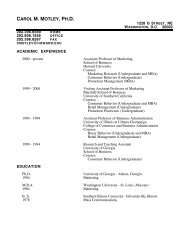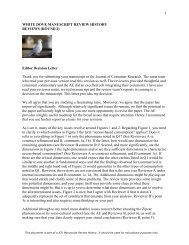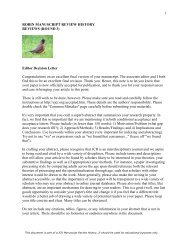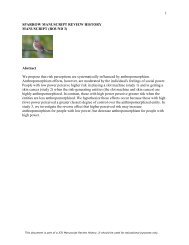Why Happiness Helps You See the Big Picture - Journal of ...
Why Happiness Helps You See the Big Picture - Journal of ...
Why Happiness Helps You See the Big Picture - Journal of ...
Create successful ePaper yourself
Turn your PDF publications into a flip-book with our unique Google optimized e-Paper software.
Copyright <strong>Journal</strong> <strong>of</strong> Consumer Research 2008.<br />
Preprint (not formatted or copyedited).<br />
Do not quote or cite without permission.<br />
4<br />
deflect <strong>the</strong> imminent threat (Pennington and Roese 2003). This implies that respondents<br />
in a positive (vs. negative) mood might disengage from important but immediate,<br />
concrete goals. However, by seeing <strong>the</strong> big picture, <strong>the</strong>y should be better able to perceive<br />
<strong>the</strong> benefits <strong>of</strong> engaging in activities that provide long-term rewards, consider future<br />
activities more important than immediate ones, and adopt whichever abstract goal is<br />
accessible.<br />
In five experiments, we investigate whe<strong>the</strong>r this is <strong>the</strong> case. We begin by<br />
demonstrating <strong>the</strong> basic effect—that positive cues (experiment 1a) and positive mood<br />
(experiment 1b) evoke abstract construal. Then, in accordance with a construal-level<br />
account, we demonstrate that participants in a positive (vs. negative) mood view abstract<br />
goals as more important and concrete goals as less important (experiment 2a) and prefer<br />
products with abstract, future-oriented benefits (experiment 2b). Finally, we demonstrate<br />
that by increasing abstract construal, a positive mood results in an increased adoption <strong>of</strong><br />
whichever abstract goal is accessible (experiment 3). We argue that <strong>the</strong>se findings are not<br />
only compatible with but also <strong>of</strong>fer a new lens through which to view <strong>the</strong> mood-asinformation<br />
perspective (Schwarz and Clore 1983).<br />
EXPERIMENT 1A: SMILING BULLETS AND ABSTRACT CONSTRUAL<br />
Experiment 1a investigates <strong>the</strong> question: Do positive cues induce abstract<br />
construal To test this basic proposition, participants completed Vallacher and Wegner’s<br />
(1989) personal agency questionnaire, a standard test <strong>of</strong> construal level that requires<br />
participants to provide descriptions <strong>of</strong> each <strong>of</strong> several activities, which are subsequently<br />
coded for level <strong>of</strong> construal. To test whe<strong>the</strong>r positive cues alter <strong>the</strong> construal level <strong>of</strong> an<br />
activity, each activity was listed next to a smiling (), a neutral (), or a frowning ()<br />
bullet point. O<strong>the</strong>rwise, <strong>the</strong> activities were identical across <strong>the</strong> three conditions. If<br />
positive cues induce abstract construal, <strong>the</strong>n <strong>the</strong> mere association <strong>of</strong> <strong>the</strong>se bullet points<br />
will alter <strong>the</strong> level at which <strong>the</strong> activities are construed. On <strong>the</strong> basis <strong>of</strong> existing research,<br />
it might be predicted that <strong>the</strong> cues will lead to valence-congruent descriptions <strong>of</strong> <strong>the</strong><br />
activities; however, unless valence ei<strong>the</strong>r corresponds with or alters construal, <strong>the</strong>re is no<br />
reason to predict an effect on <strong>the</strong> construal level <strong>of</strong> <strong>the</strong> descriptions. The type <strong>of</strong> bullet<br />
point served as a between-subjects factor, and <strong>the</strong> activities served as within-subjects<br />
replications <strong>of</strong> construal level.<br />
Method<br />
Fifty-eight undergraduate students at <strong>the</strong> University <strong>of</strong> Georgia participated in an<br />
experiment in which <strong>the</strong>y were asked to describe activities. Each participant provided <strong>the</strong><br />
first description that came to mind for each <strong>of</strong> ten activities, which were a subset <strong>of</strong> those<br />
used in Vallacher and Wegner’s (1989) study. The instructions indicated that a task can<br />
be described in many ways. For example, an activity such as painting a room can be<br />
described as beautifying <strong>the</strong> environment or as choosing a favorite color <strong>of</strong> paint. On <strong>the</strong><br />
next page, participants saw a list <strong>of</strong> different activities and were instructed to provide a<br />
description for each activity. Subsequently, two independent coders coded <strong>the</strong>se<br />
descriptions for abstractness (intercoder r = .86). To test whe<strong>the</strong>r a positive (vs. negative)<br />
cue elicits abstract construal, items in <strong>the</strong> survey were listed next to smiling (), neutral









